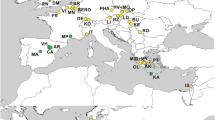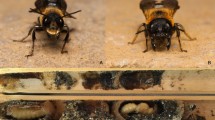Abstract
When examining how the ecosystems of remote islands have developed, it is important to know the timing of when various elements arrived and whether they then diversified. Our understanding of the histories behind the biodiverse south west Pacific (SWP) archipelagos is limited, and further impeded by the complex geological histories of this region. Previous studies of the SWP short-tongued halictine bee fauna suggest their presence is much younger than the geological ages of these archipelagos, which is surprising given their critical role as pollinators in other terrestrial ecosystems. The long-tongued megachilid bees represent a considerable proportion of the known bee species for the region, yet little is known of their origin. Here we use genetic diversity within mitochondrial DNA to infer the likely ages and origins of megachilid species from Vanuatu, Fiji, and Samoa. Our results indicate a very recent origin for megachilids in the SWP, with many species exhibiting small intraspecific genetic distances. Three species share almost identical haplotypes with specimens from Southeast Asia, suggesting multiple human-aided introductions. Combined with data from recent studies on other bee groups present in the region, our results have broad implications for how the Pacific island biota developed and how we should approach its management.


Similar content being viewed by others
References
Balke M, Wewalka G, Alarie Y, Ribera I (2007) Molecular phylogeny of Pacific Island Colymbetinae: radiation of New Caledonian and Fijian species (Coleoptera, Dytiscidae). Zoolog Scr 36(2):173–200. doi:10.1111/j.1463-6409.2006.00265.x
Bazin E, Glemin S, Galtier N (2006) Population size does not influence mitochondrial genetic diversity in animals. Science 312(5773):570–572. doi:10.1126/Science.1122033
Bird MI, Hope G, Taylor D (2004) Populating PEP II: the dispersal of humans and agriculture through Austral-Asia and Oceania. Quatern Int 118:145–163. doi:10.1016/S1040-6182(03)00135-6
Cockerell TDA (1947) A new bee from the Marshall Islands. Pan-Pac Entomol 23:68–70
Crawford A, Meffre S, Symonds P (2003) 120 to 0 Ma tectonic evolution of the southwest Pacific and analogous geological evolution of the 600 to 220 Ma Tasman Fold Belt System. Spec Pap Geol Soc Am 372:383–404
Davies O, Groom SVC, Ngo HT, Stevens MI, Schwarz MP (2013) Diversity and Origins of Fijian Leaf-Cutter Bees (Megachilidae). Pac Sci 67(4):561–570
Drummond A, Ashton B, Buxton S, Cheung M, Cooper A, Duran C, Field M, Heled J, Kearse M, Markowitz S, Moir R, Stones-Havas S, Sturrock S, Thierer T, Wilson A (2012) Geneious. 5.6.4 edn
Engel MS (2001) A monograph of the Baltic amber bees and evolution of the Apoidea (Hymenoptera). Bull Am Mus Nat Hist 259:1–192
Fall PL, Drezner TD (2013) Species origins, dispersal, and island vegetation dynamics in the South Pacific. Ann Assoc Am Geogr 103(5):1041–1057. doi:10.1080/00045608.2013.805084
Garibaldi LA, Steffan-Dewenter I, Winfree R, Aizen MA, Bommarco R, Cunningham SA, Kremen C, Carvalheiro LG, Harder LD, Afik O, Bartomeus I, Benjamin F, Boreux V, Cariveau D, Chacoff NP, Dudenhoffer JH, Freitas BM, Ghazoul J, Greenleaf S, Hipolito J, Holzschuh A, Howlett B, Isaacs R, Javorek SK, Kennedy CM, Krewenka KM, Krishnan S, Mandelik Y, Mayfield MM, Motzke I, Munyuli T, Nault BA, Otieno M, Petersen J, Pisanty G, Potts SG, Rader R, Ricketts TH, Rundlof M, Seymour CL, Schuepp C, Szentgyorgyi H, Taki H, Tscharntke T, Vergara CH, Viana BF, Wanger TC, Westphal C, Williams N, Klein AM (2013) Wild pollinators enhance fruit set of crops regardless of honey bee abundance. Science 339(6127):1608–1611. doi:10.1126/Science.1230200
Gonzalez VH, Griswold T, Praz CJ, Danforth BN (2012) Phylogeny of the bee family Megachilidae (Hymenoptera: Apoidea) based on adult morphology. Syst Entomol 37(2):261–286
Gonzalez VH, Griswold T, Engel MS (2013a) Obtaining a better taxonomic understanding of native bees: where do we start? Syst Entomol 38(4):645–653. doi:10.1111/syen.12029
Gonzalez VH, Engel M, Lucia M, Alvarez L (2013b) Species status and new distribution records for Lithurgus huberi (Hymenoptera, Megachilidae, Lithurginae). J Hymen Res 30:13–18
Goulson D (2003) Effects of introduced bees on native ecosystems. Annu Rev Ecol Evol Syst 34:1–26
Groom SVC, Schwarz MP (2011) Bees in the Southwest Pacific: Origins, diversity and conservation. Apidologie 42(6):759–770. doi:10.1007/S13592-011-0079-8
Groom SVC, Stevens MI, Schwarz MP (2013) Diversification of Fijian halictine bees: insights into a recent island radiation. Mol Phylogenet Evol 68(3):582–594. doi:10.1016/J.Ympev.04.015
Groom SVC, Ngo HT, Rehan SM, Stevens MI, Schwarz MP (2014a) Multiple recent introductions of apid bees into Pacific archipelagos signify potentially large consequences for both agriculture and indigenous ecosystems. Biol Invasions [Early online]. doi:10.1007/s10530-014-0664-7
Groom SVC, Stevens MI, Schwarz MP (2014b) Parallel responses of bees to past climate change in three isolated archipelagos of the south western Pacific. Proc Roy Soc B Biol Sci 281(1785):20133293. doi:10.1098/rspb.2013.3293
Hart SR, Coetzee M, Workman RK, Blusztajn J, Johnson KTM, Sinton JM, Steinberger B, Hawkins JW (2004) Genesis of the Western Samoa seamount province: age, geochemical fingerprint and tectonics. Earth Planet Sci Lett 227(1–2):37–56. doi:10.1016/J.Epsl.08.005
Hebert PDN, Penton EH, Burns JM, Janzen DH, Hallwachs W (2004) Ten species in one: DNA barcoding reveals cryptic species in the neotropical skipper butterfly Astraptes fulgerator. Proc Natl Acad Sci USA 101(41):14812–14817. doi:10.1073/Pnas.0406166101
Hope G, Stevenson J, Southern W (2009) Vegetation histories from the Fijian Islands: alternative records of human impact [in] the early prehistory of Fiji [electronic resource], vol 31. Terra Australis. ANU E Press, Canberra, Australia
Huelsenbeck JP, Ronquist F (2001) MrBayes: bayesian inference of phylogeny. Bioinformatics 17:754–755
Ivanova NV, Dewaard JR, Hebert PDN (2006) An inexpensive, automation-friendly protocol for recovering high-quality DNA. Mol Ecol Notes 6(4):998–1002. doi:10.1111/J.1471-8286.2006.01428.X
Jønsson KA, Bowie RCK, Moyle RG, Christidis L, Norman JA, Benz BW, Fjeldså J (2010) Historical biogeography of an Indo-Pacific passerine bird family (Pachycephalidae): different colonization patterns in the Indonesian and Melanesian archipelagos. J Biogeogr 37(2):245–257. doi:10.1111/j.1365-2699.2009.02220.x
Kaiser-Bunbury CN, Traveset A, Hansen DM (2010) Conservation and restoration of plant-animal mutualisms on oceanic islands. Perspect Plant Ecol Evol Syst 12(2):131–143. doi:10.1016/j.ppees.2009.10.002
Keogh JS, Edwards DL, Fisher RN, Harlow PS (2008) Molecular and morphological analysis of the critically endangered Fijian iguanas reveals cryptic diversity and a complex biogeographic history. Philos Trans R Soc B Biol Sci 363(1508):3413–3426. doi:10.1098/rstb.2008.0120
Keppel G, Hodgskiss PD, Plunkett GM (2008) Cycads in the insular South-west Pacific: dispersal or vicariance? J Biogeogr 35(6):1004–1015. doi:10.1111/j.1365-2699.2007.01869.x
Klein AM, Vaissiere BE, Cane JH, Steffan-Dewenter I, Cunningham SA, Kremen C, Tscharntke T (2007) Importance of pollinators in changing landscapes for world crops. Proc Roy Soc B Biol Sci 274(1608):303–313. doi:10.1098/rspb.2006.3721
Krombein KV (1950) The Aculeate Hymenoptera of Micronesia II. Colletidae, Halictidae, Megachilidae, and Apidae. Proc Hawaiian Entomol Soc XIV 1:101–142
Maddison DR, Maddison WP (2003) MacClade version 4.06. 4.06 edn. Sinauer Associates, Inc., Sunderland
Magnacca KN, Brown MJF (2012) DNA barcoding a regional fauna: Irish solitary bees. Mol Ecol Resour 12(6):990–998
Michener CD (1965) A classification of the bees of the Australian and South Pacific regions. B Am Mus Nat Hist 130:1–362
Michener CD (1979) Genus Homalictus in Fiji (Hymenoptera, Halictidae). Pac Insects 21(2–3):227–234
Michener CD (2007) The Bees of the World, 2nd edn. Johns Hopkins University Press, Baltimore, Maryland
Nunn PD (1990) Recent environmental changes on Pacific Islands. Geogr J 156:125–140
Olesen JM, Eskildsen LI, Venkatasamy S (2002) Invasion of pollination networks on oceanic Islands: importance of invader complexes and endemic super generalists. Divers Distrib 8(3):181–192
Ollerton J, Winfree R, Tarrant S (2011) How many flowering plants are pollinated by animals? Oikos 120(3):321–326. doi:10.1111/J.1600-0706.2010.18644.X
Pauly A, Munzinger J (2003) Contribution à la connaissance des Hymenoptera Apoidea de Nouvelle-Calédonie et de leurs relations avec la flore butinée. Ann Soc Entomol Fr 39(2):153–166
Pauly A, Villemant C (2009) Hyménoptères Apoidea (Insecta) de l’archipel du Vanuatu. Zoosystema 31(3):719–730
Perkins RCL, Cheesman LE (1928) Hymenoptera—Apoidea, Sphecoidea, and Vespoidea. Insects of Samoa Part V. (Fasc. 1), pp 1–32
Perkins RCL, Cheesman LE (1939) Halictine Bees from the New Hebrides and Banks Islands. Trans R Entomol Soc Lond 88:161–171
Posada D, Crandall KA (1998) Modeltest: testing the model of DNA substitution. Bioinformatics 14(9):817–818
Rainbow WJ (1896) The Insect Fauna. In: Etheridge R (ed) The Atoll of Funafuti, Ellice Group: its zoology, botany, ethnology and general structure based on collections made by charles hedley of the Australian Museum, Sydney, NSW
Rasmussen C, Carrion AL, Castro-Urgal R, Chamorro S, Gonzalez VH, Griswold TL, Herrera HW, McMullen CK, Olesen JM, Traveset A (2012) Megachile timberlakei Cockerell (Hymenoptera: megachilidae): Yet another adventive bee species to the Galapagos Archipelago. Pan-Pac Entomol 88(1):98–102
Ratnasingham S, Hebert PDN (2013) A DNA-based registry for all animal species: the barcode index number (BIN) system. PLoS ONE 8(7):e66213. doi:10.1371/journal.pone.0066213
Sheffield CS, Hebert PDN, Kevan PG, Packer L (2009) DNA barcoding a regional bee (Hymenoptera: Apoidea) fauna and its potential for ecological studies. Mol Ecol Resour 9:196–207. doi:10.1111/J.1755-0998.2009.02645.X
Sheffield C, Dumesh S, Cheryomina M (2011) Hylaeus punctatus (Hymenoptera: Colletidae), a bee species new to Canada, with notes on other non-native species. J Entomol Soc Ont 142:29–43
Silva DP, Gonzalez VH, Melo GA, Lucia M, Alvarez LJ (2014) Seeking the flowers for the bees: integrating biotic interactions into niche models to assess the distribution of the exotic bee species Lithurgus huberi in South America. Ecol Model 273:200–209
Sodhi NS, Koh LP, Brook BW, Ng PKL (2004) Southeast Asian biodiversity: an impending disaster. Trends Ecol Evol 19(12):654–660. doi:10.1016/j.tree.2004.09.006
Steadman DW, Martin PS (2003) The late Quaternary extinction and future resurrection of birds on Pacific islands. Earth Sci Rev 61(1–2):133–147. doi:10.1016/S0012-8252(02)00116-2
Swofford DL (1999) Phylogenetic analysis using parsimony (*and other methods). v.4.0. Sinaeur Associates. Sunderland, Masschusetts
Taylor GK, Gascoyne J, Colley H (2000) Rapid rotation of Fiji: paleomagnetic evidence and tectonic implications. J Geophys Res-Sol Ea 105(B3):5771–5781. doi:10.1029/1999jb900305
Whittaker RJ, Fernandez-Palacios JM (2007) Island biogeography: ecology, evolution, and conservation, 2nd edn. Oxford University Press, Oxford
Acknowledgments
We thank Marika Tuiwawa and all members of the South Pacific Regional Herbarium at the University of the South Pacific for their invaluable assistance with Fijian field logistics and expertise. Linette Berukilukilu and Plant Health and Quarantine oversaw remote field collections and facilitated permit acquisition in Vanuatu. Sampling in Samoa would not have been possible without the assistance of Afele Faiilagi and the Ministry for Natural Resources and Environment. We thank an anonymous reviewer for valuable suggestions on the manuscript. Funding for this research was gratefully received from the Australia Pacific Science Foundation, Rufford Foundation, National Climate Change Adaptation Research Facility, and the Australia Awards Endeavour Research Fellowship Program. An NSERC Discovery Grant awarded to Dr Laurence Packer funded collection and sequencing of SE Asian representatives.
Author information
Authors and Affiliations
Corresponding author
Electronic supplementary material
Below is the link to the electronic supplementary material.
10841_2014_9665_MOESM1_ESM.xls
Supplementary material 1 Table 1 Locality data and sequence ID numbers for all included sequences. Sequence ID corresponds to BOLD Systems database records except where underlined to indicate Genbank accession numbers. (XLS 70 kb)
10841_2014_9665_MOESM2_ESM.xls
Supplementary material 2 Table 2 Pairwise comparison of uncorrected p-distances for all representatives included in both distance-based and Bayesian analyses. (XLS 1589 kb)
10841_2014_9665_MOESM3_ESM.eps
Supplementary material 3 Figure 1 Bayesian phylogram with clades not collapsed as presented in Figure 1 based on mtDNA (COI) dataset. Phylogram estimated via MrBayes with GTR + I + Γ substitution prior for a dataset partitioned by 1st + 2nd, and 3rd codon positions. (EPS 2010 kb)
10841_2014_9665_MOESM4_ESM.eps
Supplementary material 4 Figure 2 Neighbour-joining phylogram based on uncorrected ‘p’ genetic distances between Megachilidae bee COI haplotypes. Scale bar indicates substitutions per nucleotide. (EPS 1945 kb)
Rights and permissions
About this article
Cite this article
Groom, S.V.C., Hayes, S.E., Ngo, H.T. et al. Recipe for disruption: multiple recent arrivals of megachilid bees in Pacific archipelagos. J Insect Conserv 18, 613–622 (2014). https://doi.org/10.1007/s10841-014-9665-1
Received:
Accepted:
Published:
Issue Date:
DOI: https://doi.org/10.1007/s10841-014-9665-1




